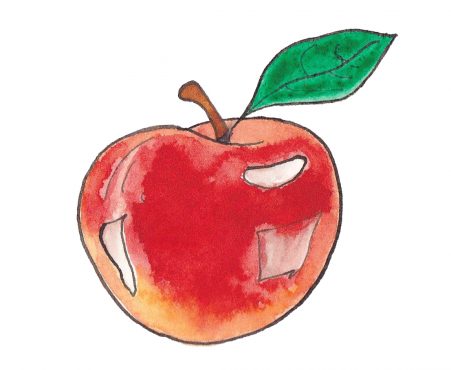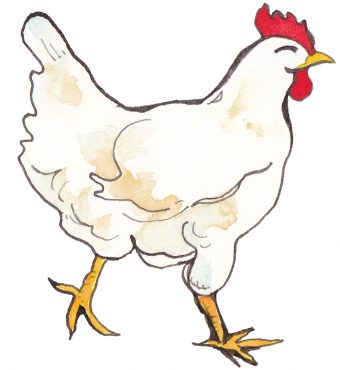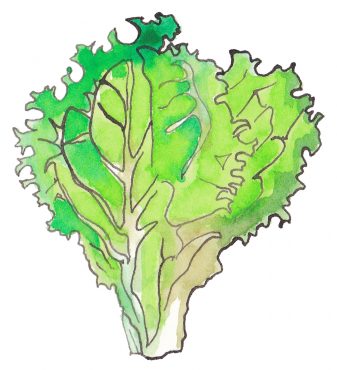How the community fills the bellies of growing minds
The aroma of juicy, oregano-scented chicken wafted throughout the hallways of the church as starving cash-strapped students filled the tables in the gymnasium.
If you were looking through the Emmanuel Baptist Church window on this unusually crisp September Tuesday night, it would have seemed as if the seven students seated at the table had been friends for years.
You would never have guessed that they had all met for the first time just minutes before.
“A chicken breast costs like five, six, seven dollars, and here you can get one for free,” Matt, one of my newly acquainted friends from the church dinner, excitedly tells me, a few minutes before a volunteer calls our table to join the line for food.
Looking at all the students sitting and grinning around me, I remember what Mankinn Gee, a student at UVic, told me while waiting in line to get into the church.
“Last year, [coming to church dinner] was kind of something [my friends and I] did intermittently,” Gee said. “Sometimes we did, sometimes we didn’t. This year we are deciding, ‘hey, it will cut costs if we all just come here for dinner on Tuesdays’.”
I wondered how many of these students are in Gee’s situation.
Twenty minutes earlier, I shuffled nervously into the Baptist Church, not knowing what to expect for my first-ever student dinner. I met David Dawson, the lead Pastor playing the role of ‘bouncer’ at the front door, and he escorted me through tables of loud chatter and plates full of chicken and vegetable curry. Some students had already started to tackle dessert—decadent tarts laid in out rows, guarded by always smiling volunteers awaiting to serve the starving students’ every need.
Pastor Dawson guides me to a table—under the yellow gymnasium lights shining down on the roaring student crowd ready to be called to the food line, he steers me to the back corner filled with students who are eagerly waiting to meet the new guest that is joining them. Although we have all just met—and are furiously hand-shaking, repeating each other’s names as if we will remember all the names once we are called to get our plate of food—I realize we are all in the same figurative boat.

We are all students — cognitively overloaded, starving students, living and learning the doldrums of adulthood in one of the most expensive cities in the country.
It’s getting more and more difficult to live on the West Coast, not just because of the housing prices that have been increasing: food prices in both B.C. more generally and Victoria have been skyrocketing.
A Statistics Canada study about the Consumer Price Index (CPI), which calculates the average prices for consumer goods such as food, looked at how much money B.C. residents spend monthly on food. The results showed a two per cent increase from $123.40 to $125.90 from August 2016 to August 2017.
Other B.C. university food banks have noticed the effects of rising food cost, specifically at SFU and UBC. In a 2015 Vancouver Sun article, Matthew Robinson wrote about the increase of post-secondary students relying on these food banks to figure out their next meal.
“More and more post-secondary students in B.C. depend on food banks to stay nourished,” Robinson wrote. “If groceries are bagged and hauled at the same rate for the remainder of the summer semester, the student-run food bank at the University of B.C. could hit its second straight 100 per cent annual increase in visits.
“At Simon Fraser University, students in need have requested 2,598 emergency grocery vouchers, since 2013.”
This is a troubling trend.
The increase of foodbank usage isn’t new: FoodBanksCanada had been documenting this trend for almost a decade, since 2008.
Their findings found that in 2008, there were 78,101 individuals assisted by a food bank in B.C.. In 2016, this number increased to 103 460 people, a staggering 32.5 per cent jump over eight years. Even accounting for population growth, it means that one in every 56 Canadians used food banks in 2008. In 2016, that number became one in every 46 .
The study also found that 17.2 per cent of people aged 18-30, the predominant ages for post-secondary students, relied on food bank assistance.
Too often, students, especially those living in Victoria with astronomical housing prices, are faced with the choice of saving money for their tuition or for their next meal.

In the bustling Cornerstone Cafe, a mere block away from the Fernwood Community Centre, Alex Harned, the Food Access Coordinator for Fernwood Neighbourhood Resource Group Society (Fernwood NRG), looks for a man nervously tapping his pen against a hardwood table. She is wondering how the person supposed to be interviewing her will know who she is in this trendy cafe.
Nevertheless, we meet, and begin to chat as coffee steamers play the role of white noise in the background.
Not too long ago, Harned was an undergrad at UVic who frequently attended the Tuesday night Emmanuel Baptist Church dinners, where she was relieved of cooking for herself for a day. She credits her idea of starting Student Dinners at Fernwood to those dinners.
“For me to have the capability of starting this (Fernwood NRG Student Dinners) was seeing a need for it,” Harned said.
“I started at UVic in 2008, and I frequented the church dinners up at the Emmanuel Church almost every Tuesday. I was a regular attendee of said dinner. I really enjoyed the concept in terms of the community food hub model bringing people together around free food access—a place to meet other students, a break from cooking one night a week—but also having a home cooked meal,” says Harned. “As someone who really appreciated that [the Emmanuel Church dinners], I wanted to replicate a similar model in Fernwood.”
Fernwood NRG just started their Student Dinners this year, with the first weekly dinner happening back on Sept 20. Their plan is to run the student dinner every Wednesday — a day after the Tuesday dinners at Emmanuel — to give students two days a week to skip cooking and to save some cash. Although a five dollar donation is recommended, students can choose to not pay anything for their food.
Another initiative the Fernwood neighbourhood has to help starving students is the /Food + Growing Workshop Series/, which teaches students how to navigate cooking for themselves.
One of the workshops is called “20-Minute Meal Preparation”, which teaches students basic knife skills, prepping and cooking techniques, and meal planning. This class costs $25, and runs Oct. 15, from 10 a.m.–12 p.m. at the Fernwood Community Centre.
Other classes range from making all sorts of cheeses, Hugelkultur bread, mushroom logs, and lessons on how to grow and use Medicinal Plants to help a variety of ailments. All of the workshops have specific dates and times, more information can be found online.
Fernwood also prides itself on using reclaimed food sources as the core of their dinner meals. Although most might instinctively think that the food provided at Fernwood is flimsy meat falling off chicken carcass, the food actually comes from three professional companies that reuse food that would have otherwise been trashed.
“90 per cent of our food from the last student dinner was sourced through reclaimed sources,” Harned explained. “I’m not talking dumpster-doven [food], but from systematic infrastructures that are being built around the reclamation of food that would otherwise would have been thrown out.”
The three companies used to source the food they use for student dinners are the Food Rescue Project, which is a part of the Mustard Seed (Victoria’s largest food bank), the Coalition of Neighborhood Houses, and SYSCO Food Distribution.
“We collectively came together and said we want to try and source more of our food from donated sources,” Harned said.

The Student Dinners at Emmanuel Baptist Church and Fernwood Community Centre are two effective ways for students to find free meals off-campus, but there is a third option located in the basement of the Student Union Building that allows cash-strapped students to find their next meal as well.
“On a single undergraduate student level, [it’s important to have] that baseline of staple foods that are nutritious and going to get you a couple solid meals a week. It makes a difference in terms of mental health, and how well you’re going to be able to do at school,” Josie Simpson, a staff member at the UVSS Food Bank and Free Store, explains.
The UVSS Food Bank combats the extremely high costs of living in Victoria by offering food to current undergraduate students and community members in need.
Current UVic students are welcome to use the Food Bank once a week, but there is no policy on tracking students visits, so the staff and volunteers rely on an ‘honesty police’ about the student’s tracking their visits. Simpson explains the Food Bank wants to preserve as much of the food on the shelves for everyone in need.
Just as Fernwood NRG offers students workshops on how to ‘survive in the real world,’ the Food Bank in the SUB also offers courses to help students to learn how to prepare meals.
Their initiative is called “The Food Skills Connection”: a community collaboration between the Food Bank, Shelbourne Community Kitchen, Community Living Victoria, Campus Community Garden, and the Community Cabbage. The program promotes food literacy programs for students. More information about the specific workshop dates are available online.
Alex Ages, another staff member at the UVic Food Bank, says she has noticed an increasing number of student visits to the Food Bank in the last few years.
“We have seen a really dramatic rise in our numbers in the past few years,” Ages says. “So many university students and college aged people in general do have to rely on this resource, at least from time to time. Right now, it isn’t sustainable for a majority of people to pay for every single thing they need to pay for, as well as [for] groceries.”
According to the statistics recorded at the UVSS Food Bank, they saw an increase of visits from 3 885 people in 2014, to 10 877 people in 2015.
Their findings correlating with the increases at SFU and UBC’s food banks from the 2015 Vancouver Sun article.
Furthermore, Ages believes there is a connection between an increase in food bank use and economical issues in the Victoria area.
“My personal views on the food bank is that it really ties directly, not just to environmental issues, but to a lot of economic issues, and seeing the reality that we are in a huge economic crisis that no politicians are dealing with or even addressing,” Ages says. “To see that our city is spending $6 million on bike lanes, when we have so many people in the Capital region alone accessing food banks who are just trying to get by and barely even surviving.”

Many of those people are here at the church eating dinner, yet not a single student is without a smile on their face. The fact the Emmanuel Baptist Church, and the Fernwood community, do this without seeking profit or fame shows these institutions truly care about the students in the Victoria area.
“We’re not looking for publicity,” said Catherine Morris, who helps to run the Emmanuel student dinners. “We really do love having students into dinner. To me, it’s like having a party every week.”
As I cut into the tender chicken breast, juices flow onto my plate, dampening the multi-grain bread roll I grabbed at the start of dinner.
I survey the other students at the dinner, and think what a relief it is for us to have all these food options at our fingertips, especially when Victoria is such an expensive city to live and learn in.
I dig back into my food, as outside the window of Emmanuel Baptist, a group of bikers using their city-funded bike lanes zips past starving students still in line outside the church.
Headline graphic by Nat Inez, Graphics Contributor. Food graphics by Yimeng Bian, Graphics Contributor








